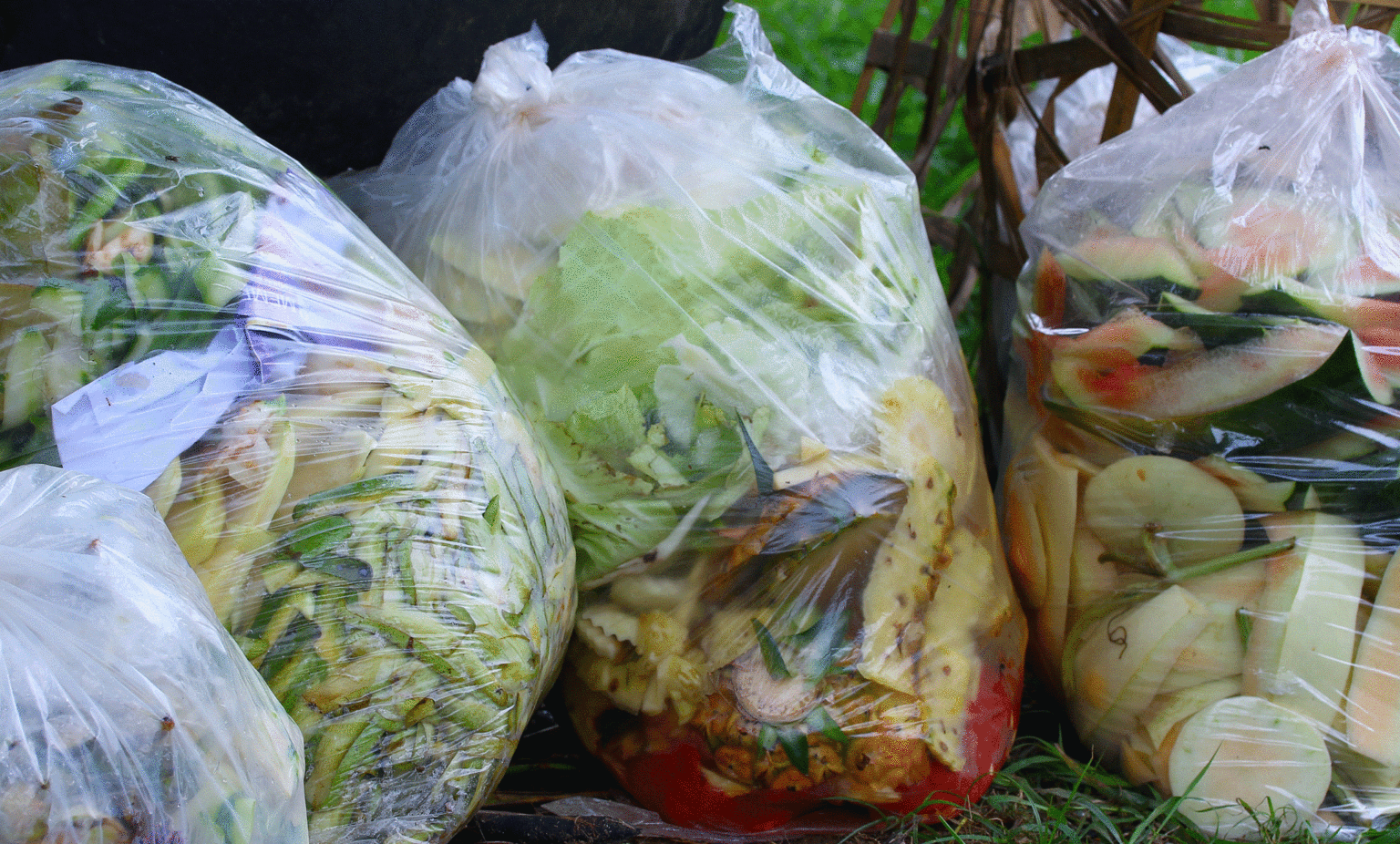I recently began following a YouTube food channel called Jolly that features two British guys, usually with a guest, trying all sorts of foods all around the world. In one episode, a chef takes them to Fallow, a restaurant in London that crafts “mind-blowingly good British food” from a conservation and sustainability perspective. The menu included corn fried with chili left over from making house sriracha, mousse made from salmon trimmings, smoked cod heads that their fish supplier would have thrown away, steak from a 12-year-old retired dairy cow, and a tart made from whey that is typically discarded after making cheese. The flavors seemed incredible, and the time, intention and passion that went into making delicious things with minimal waste (“conscious gastronomy”) were truly poignant. (fallowrestaurant.com)
>> The Problem
Food loss and waste are significant and highly solvable environmental problems today. In the United States, about 40% of our food goes to waste – that’s around 150 billion pounds of food, every year. Globally, 1/3 of food produced, about $1 trillion, is lost or wasted. The amount of food produced in the world but never eaten could feed two billion people annually. This has even been called “the dumbest problem ever,” but it is also a problem that is interdependent on many levels of the food world. From farms and restaurants to tourism, production, retail grocery and household consumption, there are varying reasons and ways this is an issue… and a solvable one.
Food “loss” refers to food that is perfectly edible and nutritious but doesn’t reach the consumer. Loss usually occurs at farm, processing and production levels. In developing countries, farmers often lack secure, dry storage facilities, so foods are exposed to pests and mold. Lack of technology, access to markets and cost of labor can force farmers to leave portions of crops in the field to rot. Farmers also face unpredictable weather, problems with harvesting or processing, and over or under production due to uncontrollable natural factors. In the first world of agriculture, there is also a value put on “pretty” produce, so farmers will often leave “ugly” vegetables to rot instead of risking not being able to sell them.
Inevitable food loss can also occur during distribution and packaging, as well as due to label confusion. In the U.S., food labels like sell by, use by, best if used by, best before, and expires on can create a lot of confusion and lead to loss as well as food surplus at grocery stores. Many of us toss out perfectly good, edible food simply because we don’t understand what these labels actually mean. This is also one of the most fixable aspects of food loss nationally, since legislation could easily standardize food labeling to indicate 1. quality (best if used by) or 2. safety (use by).
Food “waste” refers to consumption practices and issues that happen at food establishments, retail outlets and in the home. In the home kitchen, some food waste, like trimmings, scraps and brining liquids, is inevitable, but can sometimes be mitigated or upcycled. Other waste, like excess produce and preparation, is preventable with a little awareness and planning. At the retail level, grocery deals tempt us to buy too much or buy foods we won’t actually eat. Packs of food are bigger than we need – I’ve had issues lately with large bundles of celery when I just need two stalks for a soup – and a lot of packaging, both in shipping and retail, incorporates plastics and reduces the shelf life of perishable groceries. Additionally, most produce departments promote the idea that pretty produce is better produce while not incorporating composting or recycling programs for customers or employees.
Dining out in the U.S. often means large portions, multiple courses, and plenty of leftovers to either send back to the kitchen or take home and toss tomorrow. As portion sizes have grown, so has dining food waste. But both of those dilemmas are just as much the consumer’s fault as the kitchen’s. Demand and services often go hand-in-hand. Yet, while the consumer has a level of responsibility in how they invest their dollars, chefs and cooks can also find ways to operate more conservatively and sustainably, as demonstrated by restaurants like Fallow.
>> Solutions In Progress
When it comes to agriculture, governments, corporations, non-profits and individuals can encourage healthy practices, facilitate better storage and transportation facilities, and provide access to equipment, technology and markets. More outlets are popping up to rescue “ugly” and surplus produce, like America’s Imperfect Foods, Ontario, Canada’s FoodFund, and France’s Marché Second Life. Places like Preserve Farm Kitchens in California work with farmers to turn their excess produce into co-packed and private-label products, like jams, sauces and marinades. Buying local and supporting farmers’ markets, farm stands and local producers in the aisles puts more money in the farmer’s pocket and the most nutritious produce on your table.
Commercial kitchen technology, like apps that can instantly rate the freshness of meat, as well as creative recipes that use food scraps and the growth of “zero-waste” restaurant concepts are offering solutions for the service industry everywhere. One zero-waste restaurant and wine bar in Brooklyn, called Rhodora, never uses single-use plastic, shreds all cardboard into compost, and donates wine corks to make recycled shoes. The Dallas, Texas airport recycles around 32,000 pounds of cooking oil from its retailers into sustainable aviation fuel (SAF) every month. Apps, like Too Good to Go in Texas and Phenix in Hong Kong let consumers find places near them with leftover food and “surprise bags” for purchase.
In retail stores, packaging companies, like Hazel Technologies and SoFresh, are developing plastic-free products that keep perishables fresher longer and are even compostable. Apeel Sciences is working on a plant-based coating that is sprayed directly onto produce to slow spoiling. Software is now available for accurately tracking retail waste and providing results that are immediate, cost effective, and scalable. And large grocers, like Wal-mart and Albertson’s, are creating their own standardized and simplified expiration labeling systems to make buying less confusing. Whole Foods uses remnants from cut-to-order fish in soups as well as bruised produce in smoothies.

>> What Can You Do?
Individuals and households account for the largest percentage of food waste in the U.S., and most of that food goes into anaerobically processed landfills and result in environmentally damaging methane gas as it breaks down. But, as individuals, the good news is we can truly make a difference, one household decision at a time. Here are some things you can start doing today to reduce food waste:
• Read up on “best by” labels and what they actually mean.
• Shop bulk foods and produce for portions that you need.
• Ask the produce employee if they can sell you half a cabbage instead of a whole head.
• Buy ugly produce.
• If you buy a large bunch, cut up the excess and freeze it for future use.
• Find staple recipes that creatively use aging produce, food waste or leftovers, like Max La Manna’s two-ingredient potato tortillas or coffee ground pancakes.
• Collect produce trimmings in a freezer bag and use to make broth. (See in this issue “The Beauty of a Classic Broth”)
• Learn how to preserve and dry foods.
• Store foods properly to maintain freshness.
• Plan your meals and know what’s in your pantry and fridge.
• Grow your own food.
• Compost your food scraps and coffee grounds with a countertop or outdoor compost bin. This produces carbon dioxide instead of methane and makes your garden grow. N
Story by Michal Bennett



